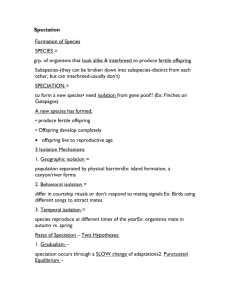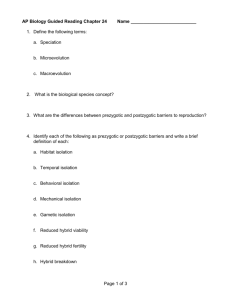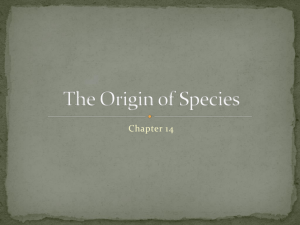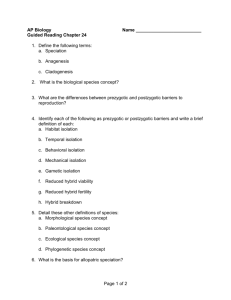Adaptation and Speciation
advertisement
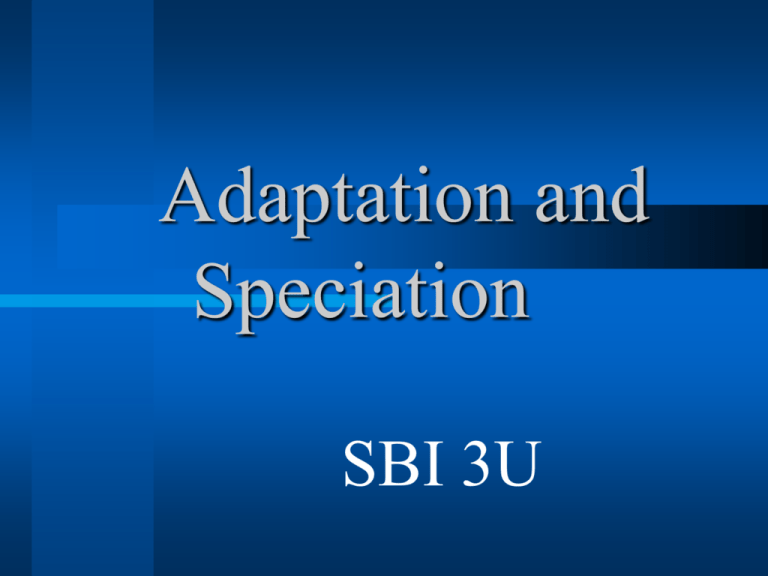
Adaptation and Speciation SBI 3U Adaptation Any trait that increases an organism’s chance of survival and probability of successful reproduction A product of natural selection Organisms become adapted to their environment over a period of time through natural selection Variations within a species are the raw material upon which natural selection acts Types of Adaptations 1. Structural Adaptation - physical features on an organism – Anatomical - shape and arrangement of features • Ex. Teeth in carnivores, vascular tissue in plants – Mimicry • Enables one species to resemble another species or part of another species – Ex. Fly that resembles a yellow-jacket wasp – Cryptic Colouration • Makes potential prey difficult to spot – Ex. Camouflage Mimicry – A palatable or harmless species mimics an unpalatable or harmful model (b) Green parrot snake (a) Hawkmoth larva Cryptic Colouration Types of Adaptations cont… 2. Physiological Adaptations – Associated with functions in organisms • • • • Ex. Enzymes for blood clotting Ex. Proteins in spiders’ silk Ex. Chemical defense in plants Ex. Ability of bacteria to withstand heat Types of Adaptations cont… 3. Behavioural Adaptations – How organisms respond to their environment – – – – Ex. Migration Ex. Courtship displays Ex. Foraging behaviour Ex. Response of plants to light How Species Form Scientist must consider the following when distinguishing one species from another: – Physiology – Biochemistry – Behaviour – Genetics Biological Species Most common definition of species: - a species consists of a reproductively compatible population - a population that can interbreed and produce viable and fertile offspring Note: Not always possible to apply this definition Forming New Species Speciation – – formation of a new species from an existing species Macroevolution Two general pathways: 1. Transformation - results from accumulated changes over long periods of time such that one species is transformed into another - also called Phyletic Speciation 2. Divergent Speciation – One or more species arise from a parent species that continues to exist – Promotes biological diversity • increases number of species *Support for both concepts suggests that a compromise or a combination of the two models works to produce new species Barriers to Reproduction Geographical Barriers – Keeps populations physically separated • Ex. Rivers Biological Barriers – Keeps species reproductively isolated when their habitats overlap Biological Barriers Pre-zygotic Barriers - prevent mating or fertilization Post-zygotic Barriers - prevent hybrid zygote from developing into a healthy fertile adult Prezygotic Barriers 1. Habitat Isolation 2. Behavioural Isolation 3. Temporal Isolation 4. Mechanical Isolation 5. Gametic Isolation Habitat Isolation Populations live in different habitats or ecological niches. Ex – mountains vs lowlands. Behavioral Isolation Mating or courtship behaviors different. Different sexual attractions operating. Ex – songs and dances in birds. Temporal Isolation Breeding seasons or time of day different. Ex – flowers open in morning or evening. Mechanical Isolation Structural differences that prevent gamete transfer. Ex – anthers not positioned to put pollen on a bee, but will put pollen on a bird. Gametic Isolation Gametes fail to attract each other and fuse. Ex – chemical markers on egg and sperm fail to match. – Separates certain closely related species of aquatic snails Post-Zygotic Barriers 1. Hybrid Inviability – Hybrid offspring are unlikely to live long • Ex. Hybrid from sheep and goat die in early development 2. Hybrid Sterility – Offspring of genetically dissimilar parents are likely to be strong but sterile • Ex. Horse + Donkey = Mule 3. Hybrid Breakdown – First generation of hybrids are viable and fertile – When hybrids mate the offspring of the next generation are sterile or weak • Ex. Cotton Types of Speciation I. Allopatric Speciation - When a population is split into two or more isolated groups by a geographical barrier - Sometimes called geographical speciation - Eventually the groups will become so distinct that interbreeding will be impossible - Isolation does not need to be indefinite, but it does need to be long enough for population to become reproductively incompatible Ex. Glacier, lava flow, ocean levels Adaptive Radiation This is a form of allopatric speciation where a common ancestral species diversifies into a variety of differently adapted species Ex. Darwin’s Finches Darwin’s Finches • II. Sympatric Speciation -When populations live in the same geographical area become reproductively isolated -More common in plants than animals -Speciation can occur in 1 generation if genetic change results from parent to offspring Ex. Extra chromosome (called polyploidy) usually in plants which can self pollinate Convergent vs. Divergent Evolution Divergent Evolution - a pattern of evolution in which species that were once similar to an ancestral species diverge, or become increasingly distinct (finches) Convergent Evolution - similar traits arise because each species has independently adapted to similar environmental conditions, not because they share a common ancestor (ex. birds and bats) The Pace of Evolution - 2 Hypotheses Gradualism – Changes occur slowly and steadily before and after a divergence – Big changes = accumulation of many small changes – Fossil record doesn’t support this hypothesis well – Fossil record shows species appearing suddenly Punctuated Equilibrium (Gould and Eldredge – 1972) – History consist of long periods stasis (no change) interrupted by periods of divergence – Most species undergo major change when they first diverge from parent species – Fossil records support this theory

